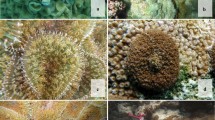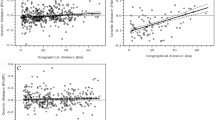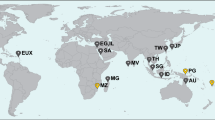Abstract
We studied how host-associations and geography shape the genetic structure of sister species of marine snails Coralliophila radula (A. Adams, 1853) and C. violacea (Kiener, 1836). These obligate ectoparasites prey upon corals and are sympatric throughout much of their ranges in coral reefs of the tropical and subtropical Indo-Pacific. We tested for population genetic structure of snails in relation to geography and their host corals using mtDNA (COI) sequences in minimum spanning trees and AMOVAs. We also examined the evolutionary relationships of their Porites host coral species using maximum likelihood trees of RAD-seq (restriction site-associated DNA sequencing) loci mapped to a reference transcriptome. A maximum likelihood tree of host corals revealed three distinct clades. Coralliophila radula showed a pronounced genetic break across the Sunda Shelf (ΦCT = 0.735) but exhibited no genetic structure with respect to host. C. violacea exhibited significant geographic structure (ΦCT = 0.427), with divergence among Hawaiian populations, the Coral Triangle and the Indian Ocean. Notably, C. violacea showed evidence of ecological divergence; two lineages were associated with different groups of host coral species, one widespread found at all sites, and the other restricted to the Coral Triangle. Sympatric populations of C. violacea found on different suites of coral species were highly divergent (ΦCT = 0.561, d = 5.13%), suggesting that symbiotic relationships may contribute to lineage diversification in the Coral Triangle.






Similar content being viewed by others
References
Ali OA, O’Rourke SM, Amish SJ, Meek MH, Luikart G, Jeffres C, Miller MR (2016) RAD Capture (Rapture): flexible and efficient sequence-based genotyping. Genetics 202:389–400
Avise JC (2000) Phylogeography: the history and formation of species. Harvard University Press, Cambridge
Barber PH, Cheng SH, Erdmann MV, Tenggardjaja K, Ambariyanto (2011) Evolution and conservation of marine biodiversity in the Coral Triangle: Insights from stomatopod Crustacea. In: Held C, Koenemann S, Schubart CD (eds) Phylogeography and population genetics in Crustacea. Crustean Issues. CRC Press, Boca Raton, pp 129–156
Barraclough TG, Vogler AP (2000) Detecting the geographical pattern of speciation from species-level phylogenies. Am Nat 155:419–434
Bastian M, Heymann S, Jacomy M (2009) Gephi: an open source software for exploring and manipulating networks. International AAAI Conference on Weblogs and Social Media
Baums IB, Miller MW, Szmant AM (2003) Ecology of a corallivorous gastropod, Coralliophila abbreviata, on two scleractinian hosts. I: Population structure of snails and corals. Mar Biol 142:1083–1091
Baums IB, Boulay JN, Polato NR, Hellberg ME (2012) No gene flow across the Eastern Pacific Barrier in the reef-building coral Porites lobata. Mol Ecol 21:5418–5433
Bhattacharya D, Agrawal S, Aranda M, Baumgarten S, Belcaid M, Drake JL, Erwin D, Foret S, Gates RD, Gruber DF, Kamel B, Lesser MP, Levy O, Liew YJ, MacManes M, Mass T, Medina M, Mehr S, Meyer E, Price DC, Putnam HM, Qiu H, Shinzato C, Shoguchi E, Stokes AJ, Tambutté S, Tchernov D, Voolstra CR, Wagner N, Walker CW, Weber APM, Weis V, Zelzion E, Zoccola D, Falkowski PG (2016) Comparative genomics explains the evolutionary success of reef-forming corals. Elife 5:e13288. https://doi.org/10.7554/eLife.13288
Bird CE, Holland BS, Bowen BW, Toonen RJ (2011) Diversification of sympatric broadcast-spawning limpets (Cellana spp.) within the Hawaiian archipelago. Mol Ecol 20:2128–2141
Bird CE, Fernandez-Silva I, Skillings DJ, Toonen RJ (2012) Sympatric speciation in the post “Modern Synthesis” era of evolutionary biology. Evol Biol 39:158–180
Bongaerts P, Riginos C, Hay KB, van Oppen MJ, Hoegh-Guldberg O, Dove S (2011) Adaptive divergence in a scleractinian coral: physiological adaptation of Seriatopora hystrix to shallow and deep reef habitats. BMC Evol Biol 11:303
Bowen BW, Rocha LA, Toonen RJ, Karl SA (2013) The origins of tropical marine biodiversity. Trends Ecol Evol 28:359–366
Briggs JC, Bowen BW (2013) Marine shelf habitat: Biogeography and evolution. J Biogeogr 40:1023–1035
Bush GL (1969) Sympatric host race formation and speciation in frugivorous flies of the genus Rhagoletis (Diptera, Tephritidae). Evolution 23:237–251
Carpenter KE, Barber PH, Crandall ED, Ablan-Lagman MCA, Ambariyanto Mahardika GN, Manjaji-Matsumoto BM, Juinio-Meñez MA, Santos MD, Starger CJ, Toha AHA (2011) Comparative phylogeography of the Coral Triangle and implications for marine management. J Mar Biol 2011:1–14
Chen M-H, Soong K, Tsai M-L (2004) Host effect on size structure and timing of sex change in the coral-inhabiting snail Coralliophila violacea. Mar Biol 144:287–293
Connell J (1973) Population Ecology of Reef-Building Corals. In: Jones O, Endean R (eds) Biology and Geology of Coral Reefs V2: Biology 1. Academic Press, INC, pp 205–244
Crandall ED, Frey MA, Grosberg RK, Barber PH (2008) Contrasting demographic history and phylogeographical patterns in two Indo-Pacific gastropods. Mol Ecol 17:611–626
Crandall ED, Sbrocco EJ, DeBoer TS, Barber PH, Carpenter KE (2011) Expansion dating: Calibrating molecular clocks in marine species from expansions onto the Sunda Shelf following the Last Glacial Maximum. Mol Biol Evol 29:707–719
DeBoer TS, Subia MD, Ambariyanto Erdmann M V, Kovitvongsa K, Barber PH (2008) Phylogeography and limited genetic connectivity in the endangered boring giant clam across the Coral Triangle. Conserv Biol 22:1255–1266
Dres M, Mallet J (2002) Host races in plant-feeding insects and their importance in sympatric speciation. Philos Trans R Soc B Biol Sci 357:471–492
Duffy JE (1996) Resource-associated population subdivision in a symbiotic coral-reef shrimp. Evolution 50:360–373
Excoffier E, Lischer H (2011) ARLEQUIN: An integrated software package for population genetics data analysis. Whats New 1–174
Faucci A, Toonen RJ, Hadfield MG (2007) Host shift and speciation in a coral-feeding nudibranch. Proc R Soc B Biol Sci 274:111–119
Fernández-González S, Pérez-Rodríguez A, de la Hera I, Proctor HC, Pérez-Tris J (2015) Different space preferences and within-host competition promote niche partitioning between symbiotic feather mite species. Int J Parasitol 45:655–662
Folmer O, Black M, Hoeh W, Lutz R, Vrijenhoek R (1994) DNA primers for amplification of mitochondrial cytochrome oxidase subunit I from diverse metazoan invertebrates. Mol Mar Biol Biotechnol 3:294–299
Fordyce JA (2010) Host shifts and evolutionary radiations of butterflies. Proc R Soc B Biol Sci 277:3735–3743
Forsman ZH, Barshis DJ, Hunter CL, Toonen RJ (2009) Shape-shifting corals: molecular markers show morphology is evolutionarily plastic in Porites. Evol Biol 9:45–54
Forsman Z, Wellington GM, Fox GE, Toonen RJ (2015) Clues to unraveling the coral species problem: distinguishing species from geographic variation in Porites across the Pacific with molecular markers and microskeletal traits. PeerJ 3:e751
Forsman ZH, Knapp ISS, Tisthammer K, Eaton DAR, Belcaid M, Toonen RJ (2017) Coral hybridization or phenotypic variation? Genomic data reveal gene flow between Porites lobata and P. compressa. Mol Phylogenet Evol 111:132–148
Fritts-Penniman A (2016) Ecological speciation and cryptic diversity of coral-associated nudibranchs. University of California, Los Angeles, PhD dissertation
Fujioka Y, Yamazato K (1983) Host selection of some Okinawan coral associated gastropods belonging to the genera Drupella, Coralliophila and Quoyula. Galaxea 2:59–73
Gaither MR, Jones SA, Kelley C, Newman SJ, Sorenson L, Bowen BW (2011) High connectivity in the deepwater snapper Pristipomoides filamentosus (Lutjanidae) across the Indo-Pacific with isolation of the Hawaiian Archipelago. PLoS One 6:e28913
Gaither MR, Rocha LA (2013) Origins of species richness in the Indo-Malay-Philippine biodiversity hotspot: Evidence for the centre of overlap hypothesis. J Biogeogr 40:1638–1648
Gittenberger A, Gittenberger E (2011) Cryptic, adaptive radiation of endoparasitic snails: Sibling species of Leptoconchus (Gastropoda: Coralliophilidae) in corals. Org Divers Evol 11:21–41
Hatfield T, Schluter D (1999) Ecological speciation in sticklebacks: environment-dependent hybrid fitness. Evolution 53:866–873
Hoeksema B (2007) Delineation of the Indo-Malayan centre of maximum marine biodiversity: the Coral Triangle. In: Renema W. (eds) Biogeography, Time, and Place: Distributions, Barriers, and lslands. Topics in Geobiology, vol 29. Springer, Dordrecht, pp 117–178
Hurt C, Silliman K, Anker A, Knowlton N (2013) Ecological speciation in anemone-associated snapping shrimps (Alpheus armatus species complex). Mol Ecol 22:4532–4548
Iacchei M, Gaither MR, Bowen BW, Toonen RJ (2016) Testing dispersal limits in the sea: Range-wide phylogeography of the pronghorn spiny lobster Panulirus penicillatus. J Biogeogr 43:1032–1044
Johannesson K, Panova M, Kemppainen P, Andre C, Rolan-Alvarez E, Butlin RK (2010) Repeated evolution of reproductive isolation in a marine snail: unveiling mechanisms of speciation. Philos Trans R Soc B Biol Sci 365:1735–1747
Johnston L, Miller MW, Baums IB (2012) Assessment of host-associated genetic differentiation among phenotypically divergent populations of a coral-eating gastropod across the Caribbean. PLoS One 7:e47630
Kearse M, Moir R, Wilson A, Stones-Havas S, Cheung M, Sturrock S, Buxton S, Cooper A, Markowitz S, Duran C, Thierer T, Ashton B, Meintjes P, Drummond A (2012) Geneious Basic: An integrated and extendable desktop software platform for the organization and analysis of sequence data. Bioinformatics 28:1647–1649
Kinlan B, Gaines S (2003) Propagule dispersal in marine and terrestrial environments: a community perspective. Ecology 84:2007–2020
Kochzius M, Nuryanto A, Genetics M (2008) Strong genetic population structure in the boring giant clam, Tridacna crocea, across the Indo-Malay Archipelago: implications related to evolutionary processes and connectivity. Mol Ecol 17:3775–3787
Kool JT, Paris CB, Barber PH, Cowen RK (2011) Connectivity and the development of population genetic structure in Indo-West Pacific coral reef communities. Glob Ecol Biogeogr 20:695–706
Krug PJ (2011) Patterns of speciation in marine gastropods: A review of the phylogenetic evidence for localized radiations in the sea. Am Malacol Bull 29:169–186
LaJeunesse TC (2005) “Species” radiations of symbiotic dinoflagellates in the Atlantic and Indo-Pacific since the Miocene-Pliocene transition. Mol Biol Evol 22:570–581
Lessios HA (2008) The great American schism: divergence of marine organisms after the rise of the Central American Isthmus. Annu Rev Ecol Evol Syst 39:63–91
Li H, Durbin R (2009) Fast and accurate short read alignment with Burrows-Wheeler transform. Bioinformatics 25:1754–1760
Li J, O’Foighil D (2012) Host-specific morphologies but no host races in the commensal bivalve Neaeromya rugifera. Invertebr Biol 131:197–203
Litsios G, Sims CA, Wüest RO, Pearman PB, Zimmermann NE, Salamin N (2012) Mutualism with sea anemones triggered the adaptive radiation of clownfishes. BMC Evol Biol 12:212
Ludt WB, Rocha LA (2015) Shifting seas: The impacts of Pleistocene sea-level fluctuations on the evolution of tropical marine taxa. J Biogeogr 42:25–38
Marko PB (2002) Fossil calibration of molecular clocks and the divergence times of geminate species pairs separated by the Isthmus of Panama. Mol Biol Evol 19:2005–2021
Marko PB, Hart MW (2011) The complex analytical landscape of gene flow inference. Trends Ecol Evol 26:448–456
Matsubayashi KW, Ohshima I, Nosil P (2010) Ecological speciation in phytophagous insects. Entomol Exp Appl 134:1–27
Miglietta MP, Faucci A, Santini F (2011) Speciation in the sea: Overview of the symposium and discussion of future directions. Integr Comp Biol 51:449–455
Moura AE, Kenny JG, Chaudhuri RR, Hughes MA, Reisinger RR, de Bruyn PJN, Dahlheim ME, Hall N, Hoelzel AR (2015) Phylogenomics of the killer whale indicates ecotype divergence in sympatry. Heredity 114:48–55
Mullen LM, Hoekstra HE (2008) Natural selection along an environmental gradient: A classic cline in mouse pigmentation. Evolution 62:1555–1570
Munday PL, Herwerden LV, Dudgeon CL (2004) Evidence for sympatric speciation by host shift in the sea. Curr Biol 14:1498–1504
Nosil P, Gompert Z, Farkas TE, Comeault AA, Feder JL, Buerkle CA, Parchman TL (2012) Genomic consequences of multiple speciation processes in a stick insect. Proc R Soc B Biol Sci 279:5058–5065
Nuryanto A, Kochzius M (2009) Highly restricted gene flow and deep evolutionary lineages in the giant clam Tridacna maxima. Coral Reefs 28:607–619
Oliverio M, Barco A, Richter A, Modica MV (2009) The coralliophiline (Gastropoda: Muricidae) radiation: Repeated colonizations of the deep sea? Nautilus 123:113–120
Oren U, Brickner I, Loya Y (1998) Prudent sessile feeding by the corallivore snail Coralliophila violacea on coral energy sinks. Proc R Soc London Ser B 265:2043–2050
Palumbi SR (1994) Genetic divergence, reproductive isolation, and marine speciation. Annu Rev Ecol Syst 25:547–572
Peccoud J, Ollivier A, Plantegenest M, Simon J-C (2009) A continuum of genetic divergence from sympatric host races to species in the pea aphid complex. Proc Natl Acad Sci 106:7495–7500
Polato NR, Concepcion GT, Toonen RJ, Baums IB (2010) Isolation by distance across the Hawaiian Archipelago in the reef-building coral Porites lobata. Mol Ecol 19:4661–4677
Prada C, Hellberg ME (2013) Long prereproductive selection and divergence by depth in a Caribbean candelabrum coral. Proc Natl Acad Sci 110:3961–3966
Prada C, De Biasse MB, Neigel JE, Yednock B, Stake JL, Forsman ZH, Baums IB, Hellberg ME (2014a) Genetic species delineation among branching Caribbean Porites corals. Coral Reefs 33:1019–1030
Prada C, McIlroy SE, Beltrán DM, Valint DJ, Ford SA, Hellberg ME, Coffroth MA (2014b) Cryptic diversity hides host and habitat specialization in a gorgonian-algal symbiosis. Mol Ecol 23:3330–3340
Prunier R, Holsinger KE, Carlson JE (2012) The effect of historical legacy on adaptation: Do closely related species respond to the environment in the same way? J Evol Biol 25:1636–1649
Puebla O (2009) Ecological speciation in marine v. freshwater fishes. J Fish Biol 75:960–996
Riginos C, Liggins L (2013) Seascape genetics: populations, individuals, and genes marooned and adrift. Geogr Compass 7:197–216
Ritson-Williams R, Shjegstad SM, Paul VJ (2009) Larval metamorphosis of Phestilla spp. in response to waterborne cues from corals. J Exp Mar Bio Ecol 375:84–88
Rocha LA (2003) Patterns of distribution and processes of speciation in Brazilian reef fishes. J Biogeogr 30:1161–1171
Schluter D, Conte GL (2009) Genetics and ecological speciation. Proc Natl Acad Sci 106:9955–9962
Skillings DJ, Bird CE, Toonen RJ (2011) Gateways to Hawai'i: genetic population structure of the tropical sea cucumber Holothuria atra. J Mar Biol 2011:1–16
Slatkin M (1987) Gene flow and the geographic structure of natural populations. Science 236:787–792
Soong K, Chen JL (1991) Population structure and sex-change in the coral-inhabiting snail Coralliophila violacea at Hsiao-Liuchiu, Taiwan. Mar Biol 111:81–86
Sotka EE (2005) Local adaptation in host use among marine invertebrates. Ecol Lett 8:448–459
Sotka EE, Wares JP, Hay ME (2003) Geographic and genetic variation in feeding preference for chemically defended seaweeds. Evolution 57:2262–2276
Tornabene L, Ahmadia GN, Berumen ML, Smith DJ, Jompa J, Pezold F (2013) Evolution of microhabitat association and morphology in a diverse group of cryptobenthic coral reef fishes (Teleostei: Gobiidae: Eviota). Mol Phylogenet Evol 66:391–400
Tsang LM, Chan BKK, Shih F-L, Chu KH, Allen Chen C (2009) Host-associated speciation in the coral barnacle Wanella milleporae (Cirripedia: Pyrgomatidae) inhabiting the Millepora coral. Mol Ecol 18:1463–1475
Villesen P (2007) FaBox: An online toolbox for FASTA sequences. Mol Ecol Notes 7:965–968
Voris H (2000) Maps of Pleistocene sea levels in Southeast Asia: shorelines, river systems and time durations. J Biogeogr 27:1153–1167
Waldrop E, Hobbs JPA, Randall JE, Dibattista JD, Rocha LA, Kosaki RK, Berumen ML, Bowen BW (2016) Phylogeography, population structure and evolution of coral-eating butterflyfishes (Family Chaetodontidae, genus Chaetodon, subgenus Corallochaetodon). J Biogeogr 43:1116–1129
Walsh PS, Metzger DA, Higuchi R (2013) Chelex 100 as a medium for simple extraction of DNA for PCR-based typing from forensic material. Biotechniques 54:506–513
Wang CY, Liu HY, Shao CL, Wang YN, Li L, Guan HS (2008) Research progress on chemical defensive substances from soft corals and gorgonians. Acta Ecol Sin 28:2320–2328
Williams ST, Benzie JAH (1998) Evidence of a phylogeographic break between populations of a high-dispersal starfish: congruent regions within the Indo-West Pacific defined by color morphs, mtDNA and allozyme data. Evolution 52:87–99
Yamashiro H, Oku H, Higa H, Chinen I, Sakai K (1999) Composition of lipids, fatty acids and sterols in Okinawan corals. Comp Biochem Physiol - B Biochem Mol Biol 122:397–407
Acknowledgements
This work was supported by three National Science Foundation programs (OISE-0730256, OISE-1243541 and OCE-0349177), and a US Agency for International Development Grant (497-A-00-10-00008-00). The Lemelson Foundation Fellowship, Conchologists of America, Sigma Xi and the UCLA Department of Ecology and Evolutionary Biology provided additional funding to S. Simmonds. We acknowledge support from the Indonesia government including the Indonesian Ministry of Research and Technology (RISTEK), Indonesian Institute of Sciences (LIPI), Nature Conservation Agency (BKSDA) and the National Marine Park offices of Bunaken and Wakatobi. Sampling was covered under research permits obtained in Indonesia (RISTEK 2011, 198/SIP/FRP/SMNl/2012, 187/SIP/FRP/SM/VI/2013), Timor-Leste (Direccao nacional de Pescase Aquicultura 0042/DNPA/IOP/VII/11), Vietnam, the Philippines (Department of Agriculture-Bureau of Fisheries and Aquatic Resources), the Maldives (Ministry of Fisheries and Aquaculture Permit No. (OTHR)30-D/INDIV/2013/116) and Hawai'i (Department of Land and Natural Resources SAP 2013-11). Thanks to C. Meyer for comments that stimulated this study. Thank you to A. Fritts-Penniman, B. Stockwell, M. Weber, H. Nuetzel and D. Willette for collecting specimens. Thanks also to Z. Forsman and C. Reboton for help identifying Porites. Thank you to M. Campbell, N. Vu and D. Eardley at the Eagle Fish Genetics Laboratory (Eagle, Idaho) for sequencing the coral DNA. Thanks to those that provided advice about or assistance with fieldwork and permits: A. Fritts-Penniman, D. Cahyani, A. Wahyu, Z.A. Muchlisin, E. Rudi, A. Muhardy, F. Hadinata, P. Usef, A. Ackiss, G. Arlotti, D. Smith, M. Sweet and R. Pooley. Diving support provided by Bali Diving Academy, Critters@Lembeh, Lorenso’s Cottages, Cubadak Paradiso Village, Komodo National Park, Freddies Santai Sumurtiga, Lumba-lumba Diving Centre, Cendrawasih Bay National Park, Papua State University, Papua Diving, Kri Eco Resorts and the Korallion Lab. We also thank the Indonesian Biodiversity Research Center at Udayana University, Institute for Environmental and Marine Sciences at Silliman University, Nha Trang University and the Korallion Lab in the Maldives for institutional support.
Author information
Authors and Affiliations
Corresponding author
Ethics declarations
Conflict of interest
On behalf of all authors, the corresponding author states that there is no conflict of interest.
Additional information
Topic Editor Dr. Line K. Bay
Electronic supplementary material
Below is the link to the electronic supplementary material.
Rights and permissions
About this article
Cite this article
Simmonds, S.E., Chou, V., Cheng, S.H. et al. Evidence of host-associated divergence from coral-eating snails (genus Coralliophila) in the Coral Triangle. Coral Reefs 37, 355–371 (2018). https://doi.org/10.1007/s00338-018-1661-6
Received:
Accepted:
Published:
Issue Date:
DOI: https://doi.org/10.1007/s00338-018-1661-6




